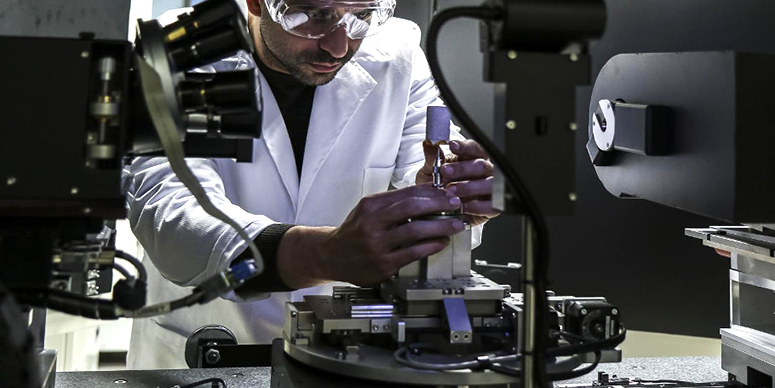Oil and gas companies are continuously striving for ways to make the E&P of hydrocarbons a more cost-effective process. Within the E&P process there are many uncertain stages that must be resolved to determine a reservoir’s potential and to optimize the production plan for each exploration project. To respond to these variables, operators need to gain a more detailed vision of the subsurface and a deeper knowledge of a rock’s properties and the interactions that occur within its structure.
Repsol is working on developing cutting-edge E&P technology. The Repsol Technology Center (RTC) is these R&D initiatives. Opened in 2002, the center unifies the efforts of four research facilities that Repsol previously ran in different regions of Spain. Its objective is to promote the strategic projects that aim to fulfill current and future energy needs through the creation of more efficient and environmentally sustainable energy systems.
The RTC is the base for more than 300 scientists and researchers who are able to maximize their use of the center’s facilities to develop new tools and practices for energy discovery. Through the implementation of these tools Repsol has been able to successfully detect new deposits with an exploration success rate above that of the global average.
Looking For More Energy
Behind Repsol’s energy discovery initiatives are a range of pioneering projects that aim to increase the efficiency of hydrocarbon E&P processes. Through its research projects Repsol is able to offer innovative solutions in all areas of the energy process, from the exploration of hydrocarbons to their transformation into value-added products. Repsol’s research projects drive continuous improvement in the deposit detection process, to the point where the company has achieved the highest exploration success rate in the industry, 33% in 2014.
Sherlock I
Repsol’s R&D objectives to improve the exploration success rate and to reduce uncertainty through the geological evaluation, validation and calibration of hydrocarbon reservoirs was the catalyst for an innovative project called Sherlock. This unique methodology was developed jointly by the RTC and the Geological Exploration Disciplines team.
The Sherlock Project was launched in 2009. Sherlock enables Repsol to develop and implement a methodology based on petrographic microscopy and high-resolution geochemical analysis techniques to characterize the multiple different elements of oil systems. As such, the Sherlock Project has demonstrated its ability to reduce geological risk and increase the exploration success rate.
By taking different samples of rock cores and cuttings received from various geographic locations, scientists strive to learn all they can from the reservoirs and to determine when, how and where the oil was formed and accumulated.
Since the launch of the Sherlock Project, Repsol has increased its exploration success rate. Research of this type is paramount for making improved decisions, both in the search for new oil fields and the future of proven reservoirs in terms of obtaining the same barrels of oil but with fewer wells, thereby reducing the environmental impact of extraction.
Many studies have been carried out at various business units in Morocco, Mauritania, Libya, Algeria andBrazil that have demonstrated the potential of this new methodology, both for exploration projects and field development.
Sherlock II
In January 2016 Repsol scientists successfully concluded Sherlock II, a new project that combines data science, physics and sophisticated numerical methods to create digital representations of subsoil rocks.
Sherlock II is designed to take 3-D X-ray scans of rock fragments, creating a “digital rock” for reproduction and study in a virtual laboratory.
The use of cutting-edge X-ray tomography and the creation of 3-D rock models allows scientists to realistically analyze properties such as porosity, permeability and the interactions between the rock and its internal fluids. This helps them to determine if a reservoir is profitable and how best to extract oil or gas.
In addition, digitalization makes it easier to analyze not only cores but also rock fragments, wherever they are located. With Sherlock II experiments that used to take three months can now be done in three weeks.
Furthermore, Sherlock II enables the company to obtain information and answer geological questions about oil and gas deposits through the power of computing. An important component is the technology’s ability to source, analyze and filter Big Data to make well-founded decisions.
By transforming stones into data, researchers can accumulate geological knowledge that lasts as long as the rocks themselves.
Repsol’s investment in digital petrophysics has turned the RTC into a pioneer in this field. Over the last few years the research has been tested with good results in several pilot projects, saving up to 70% in operating costs compared to other commercial technologies.
Sherlock also is being applied to unconventional reservoirs or those with complex geologies, where a substantial proportion of unexplored resources reside.
Tackling Challenges Through Technology
Repsol believes in the synergies between traditional methods and state-of-the-art digital technology. Combined with expert knowledge and pioneering practices, this represents a great strength in overcoming the challenges that lie ahead in this new phase of hydrocarbon E&P. The company is committed to the continued development of technological solutions that will enable scientists and researchers to make better decisions on potential and proven reservoirs and to effectively gather information with minimal environmental disturbance.
As oil and gas companies continue to explore areas that are deeper and farther offshore, innovative technologies are vital to maintain a competitive edge in the current economic climate.
Greater efficiency in decision-making and operations and reduced exploration risk are only three of the numerous advantages that intelligent, computer-driven technology represents. With this in mind, Repsol will continue to develop technology that will allow scientists and researchers to make better decisions about future opportunities and to obtain better results with more efficient operations and fewer disturbances to the environment.


 石油圈
石油圈
